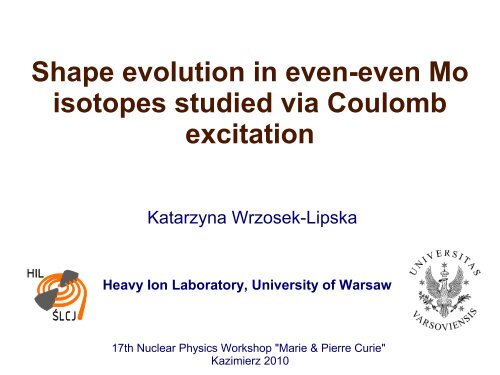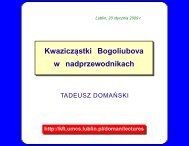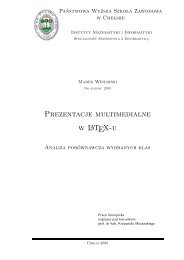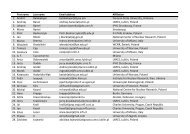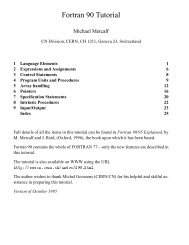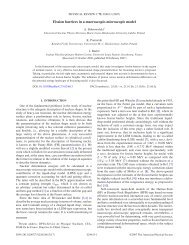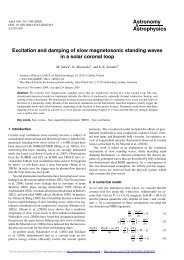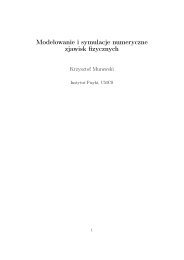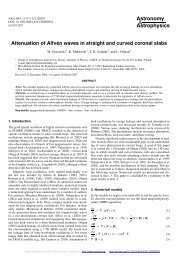Shape evolution in even-even Mo isotopes studied via ... - Lublin
Shape evolution in even-even Mo isotopes studied via ... - Lublin
Shape evolution in even-even Mo isotopes studied via ... - Lublin
Create successful ePaper yourself
Turn your PDF publications into a flip-book with our unique Google optimized e-Paper software.
<strong>Shape</strong> <strong>evolution</strong> <strong>in</strong> <strong>even</strong>-<strong>even</strong> <strong>Mo</strong><br />
<strong>isotopes</strong> <strong>studied</strong> <strong>via</strong> Coulomb<br />
excitation<br />
Katarzyna Wrzosek-Lipska<br />
Heavy Ion Laboratory, University of Warsaw<br />
17th Nuclear Physics Workshop "Marie & Pierre Curie"<br />
Kazimierz 2010
Outl<strong>in</strong>e<br />
<strong>Mo</strong>tivation.<br />
Quadrupole Sum Rules method – practical application to the<br />
stable <strong>Mo</strong> <strong>isotopes</strong>.<br />
Quadrupole deformation parameters of the heaviest stable <strong>Mo</strong><br />
<strong>isotopes</strong>.<br />
Comparison of the experimentally obta<strong>in</strong>ed results with the<br />
General Bohr Hamiltonian calculations.<br />
Conclusions
<strong>Mo</strong>tivation<br />
Transitional nuclei (A~100) challeng<strong>in</strong>g for nuclear structure theories:<br />
competition of s<strong>in</strong>gle-particle and collective excitation modes.<br />
In the Sr and Zr isotopic cha<strong>in</strong> a dramatic change of the ground state<br />
structure is observed at N = 58, 60.<br />
This effect is less pronounced <strong>in</strong> <strong>Mo</strong> <strong>isotopes</strong>, but still the rapidity of shape<br />
change gives rise to shape coexistence <strong>in</strong> these nuclei.
<strong>Mo</strong>tivation<br />
Transitional nuclei (A~100) challeng<strong>in</strong>g for nuclear structure theories:<br />
competition of s<strong>in</strong>gle-particle and collective excitation modes.<br />
In the Sr and Zr isotopic cha<strong>in</strong> a dramatic change of the ground state<br />
structure is observed at N = 58, 60.<br />
This effect is less pronounced <strong>in</strong> <strong>Mo</strong> <strong>isotopes</strong>, but still the rapidity of shape<br />
change gives rise to shape coexistence <strong>in</strong> these nuclei.<br />
E exc<br />
(2 + 1 )<br />
[keV]<br />
1000<br />
Zr<br />
Sr<br />
<strong>Mo</strong><br />
Ru<br />
100<br />
52 54 56 58 60 62 64<br />
NEUTRON NUMBER
<strong>Mo</strong>tivation<br />
Transitional nuclei (A~100) challeng<strong>in</strong>g for nuclear structure theories:<br />
competition of s<strong>in</strong>gle-particle and collective excitation modes.<br />
In the Sr and Zr isotopic cha<strong>in</strong> a dramatic change of the ground state<br />
structure is observed at N = 58, 60.<br />
This effect is less pronounced <strong>in</strong> <strong>Mo</strong> <strong>isotopes</strong>, but still the rapidity of shape<br />
change gives rise to shape coexistence <strong>in</strong> these nuclei.<br />
E exc<br />
(2 + 1 )<br />
[keV]<br />
1000<br />
Zr<br />
Sr<br />
<strong>Mo</strong><br />
Ru<br />
100 <strong>Mo</strong><br />
96 <strong>Mo</strong><br />
98 <strong>Mo</strong><br />
100<br />
52 54 56 58 60 62 64<br />
NEUTRON NUMBER
<strong>even</strong>-<strong>even</strong> <strong>Mo</strong> <strong>isotopes</strong><br />
Low-ly<strong>in</strong>g 0 + states characteristic for transitional nuclei (A~100 around N = 60)<br />
In extreme cases the second 0 + state appears to be the first excited state.<br />
STABLE<br />
UNSTABLE<br />
92<br />
<strong>Mo</strong> 50<br />
94<br />
<strong>Mo</strong> 52<br />
96<br />
<strong>Mo</strong> 54<br />
98<br />
<strong>Mo</strong> 56<br />
100<br />
<strong>Mo</strong> 58<br />
102<br />
<strong>Mo</strong> 60<br />
104<br />
<strong>Mo</strong> 62<br />
106<br />
<strong>Mo</strong> 64<br />
8.4 W.u. 16 W.u. 21 W.u. 20 W.u. 37 W.u. 74 W.u. 92 W.u. 87 W.u.
96<br />
<strong>Mo</strong> 54<br />
98<br />
<strong>Mo</strong> 56<br />
100<br />
<strong>Mo</strong> 58<br />
Such a rare structure - first experimental <strong>in</strong>dication of shape coexistence<br />
phenomenon.<br />
What is the shape of the two lowest 0 + states <strong>in</strong> the heaviest stable<br />
96,98,100 <strong>Mo</strong> <strong>isotopes</strong><br />
Low-energy Coulomb excitation – the only experimental technique that<br />
can dist<strong>in</strong>guish between prolate and oblate character of the deformation of<br />
the <strong>in</strong>vestigated nucleus for each level.
Coulomb excitation experiments @ HIL <strong>in</strong> Warsaw<br />
32<br />
S<br />
100<br />
<strong>Mo</strong><br />
76 MeV<br />
particle detection system: 44 PiN<br />
diodes placed at backward angles<br />
(θ LAB<br />
= 112 O – 152 O )<br />
Gamma rays detection array: OSIRIS-II<br />
spectrometer (12HPGe detectors)<br />
The deexcitation γ rays mesured <strong>in</strong> co<strong>in</strong>cidence with backscattered particles.<br />
A complete set of E2 matrix elements, <strong>in</strong>clud<strong>in</strong>g signs and magnitudes, can be<br />
extracted for low-ly<strong>in</strong>g states <strong>in</strong> nuclei.
Reduced matrix elements <strong>in</strong> 96,98,100 <strong>Mo</strong><br />
96 <strong>Mo</strong> 98 <strong>Mo</strong> 100 <strong>Mo</strong><br />
HIL (Warsaw), JAERI<br />
(Tokai)<br />
26 reduced E2 and M1<br />
matrix elements:<br />
3 diagonal E2 matrix<br />
elements<br />
20 transitional E2 matrix<br />
elements<br />
3 transitional M1 matrix<br />
elements<br />
HIL (Warsaw), JAERI<br />
(Tokai)<br />
19 reduced E2 and M1<br />
matrix elements:<br />
4 diagonal E2 matrix<br />
elements<br />
13 transitional E2 matrix<br />
elements<br />
2 transitional M1 matrix<br />
elements<br />
HIL (Warsaw)<br />
26 reduced E2, E1, E3,<br />
M1 matrix elements:<br />
4 diagonal E2 matrix elements<br />
16 transitional E2 matrix<br />
elements<br />
2 transitional M1 matrix<br />
elements<br />
2 transitional E1 and E3 matrix<br />
elements
Reduced matrix elements <strong>in</strong> 96,98,100 <strong>Mo</strong><br />
96 <strong>Mo</strong> 98 <strong>Mo</strong> 100 <strong>Mo</strong><br />
HIL (Warsaw), JAERI<br />
(Tokai)<br />
26 reduced E2 and M1<br />
matrix elements:<br />
3 diagonal E2 matrix<br />
elements<br />
20 transitional E2 matrix<br />
elements<br />
3 transitional M1 matrix<br />
elements<br />
HIL (Warsaw), JAERI<br />
(Tokai)<br />
19 reduced E2 and M1<br />
matrix elements:<br />
4 diagonal E2 matrix<br />
elements<br />
13 transitional E2 matrix<br />
elements<br />
2 transitional M1 matrix<br />
elements<br />
HIL (Warsaw)<br />
26 reduced E2, E1, E3,<br />
M1 matrix elements:<br />
4 diagonal E2 matrix elements<br />
16 transitional E2 matrix<br />
elements<br />
2 transitional M1 matrix<br />
elements<br />
2 transitional E1 and E3 matrix<br />
elements
Rotation <strong>in</strong>variant <br />
Quadrupole Sum Rules Method (D. Cl<strong>in</strong>e, Ann. Rev. Nucl. Part. Sci. 36 (1986) 683)<br />
For E2 transitions from the 0 + states one can form quadrupole tensor<br />
products coupled to angular momentum 0 – i.e. rotation <strong>in</strong>variant<br />
is an overall quadrupole deformation parameter
Rotation <strong>in</strong>variant <br />
Quadrupole Sum Rules Method (D. Cl<strong>in</strong>e, Ann. Rev. Nucl. Part. Sci. 36 (1986) 683)<br />
For E2 transitions from the 0 + states one can form quadrupole tensor<br />
products coupled to angular momentum 0 – i.e. rotation <strong>in</strong>variant<br />
is an overall quadrupole deformation parameter
Determ<strong>in</strong>ation of the overall quadrupole deformation of 100 <strong>Mo</strong>
Determ<strong>in</strong>ation of the overall quadrupole deformation of 100 <strong>Mo</strong>
Rotation <strong>in</strong>variant <br />
Quadrupole Sum Rules Method (D. Cl<strong>in</strong>e, Ann. Rev. Nucl. Part. Sci. 36 (1986) 683)<br />
To get <strong>in</strong>formation on triaxiality the higher order <strong>in</strong>variant is needed:<br />
is a triaxiality parameter
Rotation <strong>in</strong>variant <br />
Quadrupole Sum Rules Method (D. Cl<strong>in</strong>e, Ann. Rev. Nucl. Part. Sci. 36 (1986) 683)<br />
To get <strong>in</strong>formation on triaxiality the higher order <strong>in</strong>variant is needed:<br />
is a triaxiality parameter
Determ<strong>in</strong>ation of the triaxiality of 100 <strong>Mo</strong>
Determ<strong>in</strong>ation of the triaxiality of 100 <strong>Mo</strong>
Quadrupole shape parameters of 96,98,100 <strong>Mo</strong><br />
triaxial<br />
is a measure of an overall deformation (analogous to Bohr's β)<br />
is a measure of triaxiality (analogous to Bohr's γ)
Quadrupole deformation parameters of 100 <strong>Mo</strong>: exp vs theory<br />
General quadrupole collective Bohr Hamiltonian calculations<br />
(L. Próchniak Int. J. <strong>Mo</strong>d. Phys. E19 (2010) 705,<br />
L. Próchniak, S. G. Rohoziński, J. Phys. G: Nucl. Part. 36 (2009) 123101)<br />
triaxial<br />
GBH calculations with the SLy4 variant of Skyrme <strong>in</strong>teraction <strong>in</strong>dicate better<br />
agreement with experimentally obta<strong>in</strong>ed quadrupole deformation parameters.
Level structure of 100 <strong>Mo</strong>: exp vs theory<br />
L. Próchniak Int. J. <strong>Mo</strong>d. Phys. E19 (2010) 705<br />
experiment GBH (SIII) GBH (SLy4)
Conclusions:<br />
Hav<strong>in</strong>g the experimental magnitudes and signs of the E2 matrix elements, the expectation<br />
values of quadrupole <strong>in</strong>variants and for a given state may by<br />
calculated.<br />
Quadrupole shape parameters of the two lowest 0 + states <strong>in</strong> 96,98,100 <strong>Mo</strong> nuclei were <strong>in</strong>ferred<br />
from Coulomb excitation data <strong>in</strong> a nuclear model <strong>in</strong>dependent way (Quadrupole Sum Rules<br />
method).<br />
The overall deformation of 96,98,100 <strong>Mo</strong> <strong>in</strong> the 0 + states <strong>in</strong>creases with the neutron number.<br />
The overall deformation of 100 <strong>Mo</strong> <strong>in</strong> the 0 + states shows <strong>in</strong>verse trend than <strong>in</strong> 96 <strong>Mo</strong> – 0 + gs state<br />
of 100 <strong>Mo</strong> is less deformed than 0 + exc one. The shape of 96-100 <strong>Mo</strong> changes from triaxial (the<br />
0 + gs state) to the prolate one (the 0+ exc state).<br />
GBH calculations with the SLy4 variant of Skyrme <strong>in</strong>teraction lead to better agreement<br />
with experimentally obta<strong>in</strong>ed quadrupole deformation parameters.<br />
FUTURE PLANS:<br />
What is the <strong>evolution</strong> of the deformation of low-ly<strong>in</strong>g 0 + states <strong>in</strong> more neutron-rich <strong>Mo</strong><br />
<strong>isotopes</strong>
Collaboration:<br />
K. Wrzosek-Lipska a , M. Zielińska a , K. Hadyńska-Klęk a,b , J. Iwanicki, M. Kisieliński a ,<br />
M. Kowalczyk a,b , P. J. Napiorkowski a , L. Pieńkowski a , D. Piętak a , J. Srebrny a<br />
a<br />
Heavy Ion Laboratory, University of Warsaw, Poland<br />
b<br />
Institute of Experimental Physics , University of Warsaw, Poland<br />
L. Próchniak, K. Zając<br />
Maria Curie-Skłodowska University, Lubl<strong>in</strong>, Poland<br />
Y. Toh c , M. Oshima c , A. Osa c , Y. Utsuno c , Y. Hatsukawa c , J. Katakura c ,<br />
M. Koizumi c , M. Matsuda c , T. Shizuma c , M. Sugawara d , T. <strong>Mo</strong>rikawa e , H. Kusakari f<br />
c Japan Atomic Energy Research Institute, Tokai, Ibaraki, Japan<br />
d Chiba Institute of Technology, Narash<strong>in</strong>o, Chiba, Japan<br />
e Kyushu University, Hakozaki, Fukuoka, Japan<br />
f Chiba University, Inage-ku, Chiba, Japan


